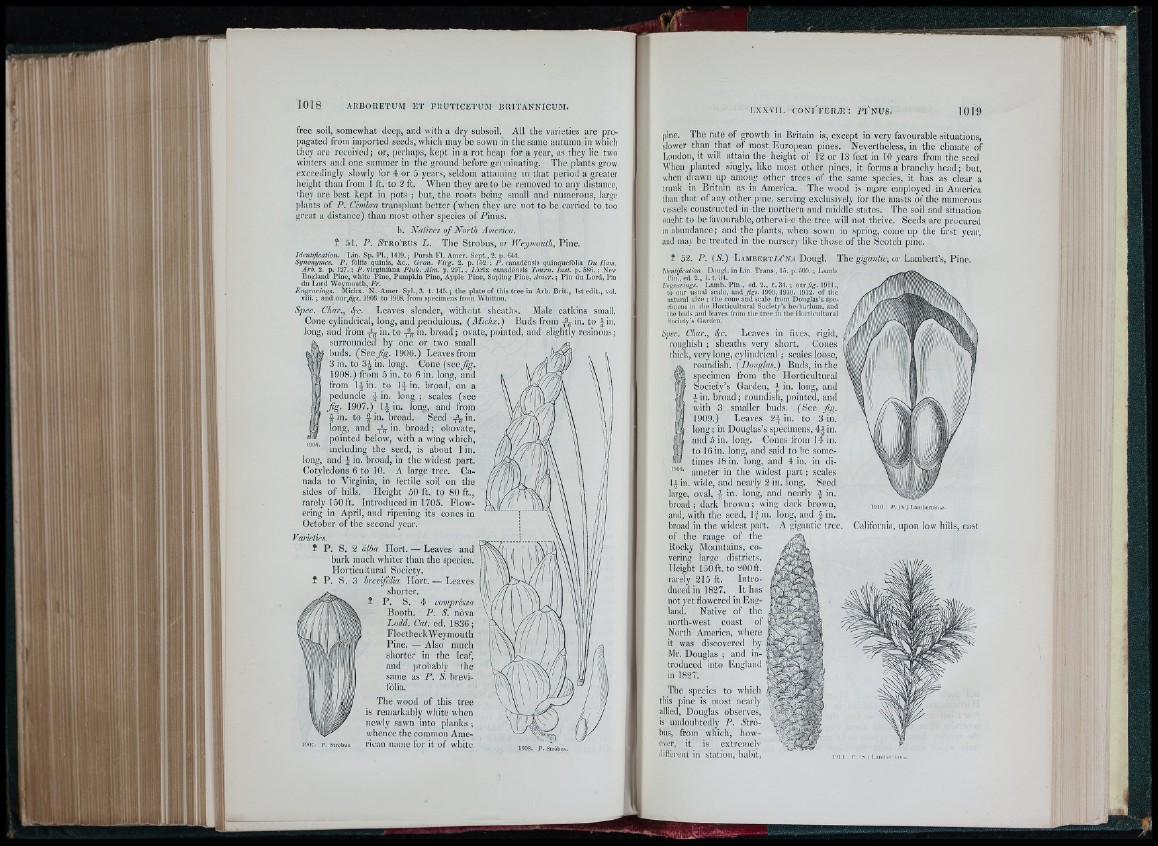
free soil, somewhat deep, and with a dry subsoil. All the varieties are propagated
from imported seeds, which may be sown in the same autumn in which
tliey are received; or, perhaps, kept in a rot heaj) for a year, as they lie two
winters and one summer in the ground before genuinating. The plants grow
exceedingly slowly for 4 or 5 years, seldom attaining in that jieriod a greater
iieiglit than from 1 ft. to 2 ft. Wlmn they are to he removed to any distance,
(hey are best kept in pots ; hut, the roots being small and nunuii’ous, large
plants of P. Canòra transplant hotter (when they are not to he carried to too
great a distance) than most oilier species of Pimis.
I). Natives o f North America.
i 51. P. ¿ tro 'b u s L . The Strobus, or Weymouth, Pine.
Identification. Lin. Sp. PI., 1419.; Pursh Fl. Amer. Sept., 2. p. 644.
Synonymes. P . fòiiis qulms, &c., Gron. Virg. 2. p. ir)2. ; P . canadénsis quinqnefòlia Du Ilam.
Arh. 2. p. 127. ; P. virginiàna Pluk. Aim. p. 297. ; /.iirix canadénsis Tourn. Inst. p. 586. ; New
England Pine, white Pine, Pumpkin Pine, Apple I ’ine, Sapling Pine, Amer. ; Pin du Lord, Pin
du Lord Weymouth, Fr.
Engravings. Iviichx. N. Amer. Syi., 3. t. 145.; the plate of this tree in Arb. Brit., 1st edit., vol,
viii. ; and om fig s. 1906. to 1908. from specimens from Whitton.
Spec. Char., Leaves slender, without sheaths. Male catkins small.
Cone cylindrical, long, and pendulous. (Michx.) Buds from in. to l in.
long, and from -?!^in.to -5^ in. broad; ovate, ¡xjinted, and slightly resinous;
surrounded by one or two small
buds. (See fig. 1906.) Lcaves from
3 in. to 3A in. long. Cone (sec fig.
1908.) from 5 in. to 6 in. long, and
from l |iu . to lifin. broad, on a
peduncle ^ in. long ; scales (see
fig. 1907.) 14-iu. long, and from
|-in. to fin. broad. Seed ^^in.
long, and in. broad ; obovate,
pointed below, with a wing which,
including the seed, is about 1 in.
long, and f in. broad, in the widest part.
Cotyledons 6 to 10. A large tree. Canada
to Virginia, in fertile soil on the
sides of hills. Height 50 ft. to 80 ft.,
rarely 150ft. Introducedin 1705. Flowering
in April, and ripening its cones in
October of the second year.
Varieties.
1 P. S. 2 àtòa Hort. — Leaves and
bark much whiter than the species.
Horticuitural Society,
i P. S. 3 brevifdlia Ho rt.— Leaves
shorter.
P. S. 4 comjD'éssa
Booth. P. S. nova
Lodd. Cat. ed. 1836 ;
Floetbeck Weymouth
Pine. — Also much
shorter in the leaf,
and probably the
same as P. S. hrevi-
fòlia.
The wood of tliis tree
is remarkably white when
newly sawn into planks ;
wiience the common Ame-
I'lor. p. suùbuB. rican name for it of white
pine. The rate of growtii iu Britain is, except in very favourable situations,
slower than that of most European [lines. Nevertheless, in the climate of
London, it will attain the height of 12 or 13 feet in 10 years from the seed
When planted singly, like most other pines, it forms a branchy head; but,
when drawn up among other trees of the same species, it has as clear a
trunk in Britain as in America. The wood is mpre employed in America
than that of any other pme, serving exclusively for the masts ofthe numerous
vessels constructed in the northern and middle states. 'Fhe soil and situation
oiiglit to be favourable, otherv\ise the tree will not thrive. Seeds are [irocured
ill abundance; and the plants, when sown in spring, come up the first year,
and may be treated in the nursery like tliose of the Scotch pine.
i 52. P. (S .) Lambkut//4'Na/Dougl. The or Lambert’s, Pine.
Uentification. Dougl. in Lin, Trans , 15, p. .500. ; Lamb.
Pm.,ed. 2., I. t. 34.
Kngravings. Lamb. Pin., ed. 2., t. 34. ; om fig . 19]].,
to our usual scale, and figs. 1909, 1910. 1912. of tlie
natural sizo ; the cone and scale from Douglas’s si>o-
cinunis in the Horticultural Society’s hcibarinm, and
tlie buds ¡uid leaves from the tree in the Horticultural
Society's Garden.
Spec. Char., Leaves in fives, rigiti,
roughish ; slieatlis very short. Cones
tliick, very long, cylindrical ; scales loose,
roundish. (JJong/as.) Buds, in the
specimen from the Horticulturai
Society’s (iardcn, l in. long, and
Lin. broad; roundish, pointed, and
with 3 smaller buds. (See fig.
1909.) Leaves 2;} in. to 3 in.
long; in Douglas’s specimens, 4-Lin.
and 5 in. long. Cones from 14 in.
to 16 in. long, and said to be sometimes
18 in. long, and 4 in. in di-
ameter in the witlest p a r t; scales
liin . wide, and nearly 2 in. long. Seed
large, oval, in. long, and nearly in.
broad ; dark brown; wing dark brown,
and, with the seed, 1 ;,-in. long, and ^in.
broad in the 'widest part. A gigantic tree,
of the range of tlie
Rocky Mountains, covering
large districts.
Height 150 ft. to 200 ft.
rarely 215 ft. Introducedin
1827. It has
not yet flowered in England.
Native of thc
north-west coast of
North America, where
it was discovered by
Mr. Douglas ; and introduced
into E.ngland
in 1827.
The species to wdiicli
this pine is most nearly
allied, Douglas observes,
is undoulitedly P. Ntro-
Inis, from which, however,
it is extremely
iliffereiit in station, haliit,
lü lO. P . (S.) LamliertwjK
California, u])on low hills, east